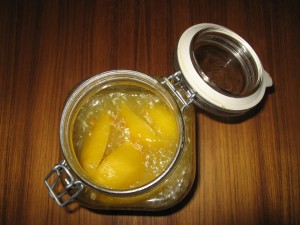Preserving lemons is one of the most simple and fun ways to start home preserving.
Only organic lemons have skins that are guaranteed free of waxes and preservatives, so making them out of organic fruit is essential. With the final preserved lemons, only the soft and delectable skins are eaten, so it’s absolutely essential your little tart treats are totally safe and healthy and not covered in nasty pesticides or gunk. Preserving home-grown lemons is a perfect thing to do if you live in Southern California like me. The lemon varieties that thrive here are similar to the varieties that grow in the Mediterranean, so the finished preserved lemon flavors are more authentically Moroccan-style. But any lemons, homegrown or store-bought, are delicious when they’re preserved in this time-honored method. Just as long as they’re organic.
This is the most delicious and indispensable everyday ingredient that you’ve yet to taste. Once you have made preserved lemons from scratch, you won’t know how you ever made delicious things without them. Salty, citrusy, strongly-flavored and tart, they’re a central ingredient in Moroccan cuisine and also show up now and then in South East Asian foods.
Maximum taste to preparation time benefits ratio… Here’s the process:
1. Carefully boil a big glass canning jar to sterilize it, then leave it to air-dry upside down on a clean cloth.
2. Wash and dry five big juicy lemons.
3. On a chopping board, cut each lemon into quarters lengthwise, from the stem to the pointed end… But, leave them attached at the stem end so that the quarters hold together.
4. Using your fingers, stuff each lemon with about one tablespoon of sea salt or kosher salt. Don’t use regular table salt, as it has added iodine so won’t pickle the lemons properly.
5. Squash all the cut, salted lemons inside the jar, pressing them down.
6. Close the jar, and leave in a dark, cool cupboard for 3-4 days, depending on the time of year and heat in the cupboard.
7. When you open the jar, the lemons will be softer, so you will be able to squash them down more, squeezing juice out of them as you do so.
8. Add the juice of about 5-6 more lemons so that all the lemons in the jar are covered.
9. If needed, add a weight of some kind, such as a saucer, to keep any bits of lemon from bobbing above the surface. They need to be fully immersed in the salted juice.
10. Back into the cupboard for at least a month and up to one year. Pull off quarter segments as needed, using a knife and fork to keep your fingers out of the liquid.
The liquid gets better and better over time. Little clumps of white stuff arrive after a while, but it’s completely harmless, like the dusty white stuff on the outside of grapes or the bloom on cheese. Feel free to throw more lemon peels into the juice for up to a year. Just remember somehow which peels are new to the pickle jar, and which ones have been in there for a month or more.
To use your preserved lemons, discard the pulp. Then rinse the peel with fresh cold water if you want to remove the brine for a less salty taste, or leave them unwashed if you want more punch. Either way, mince the peels finely, or try them thinly sliced. You can add the peels to sauces, condiments, pastes, sandwiches, salads or any recipes that would taste great with a salty, pickled peel.
Think of them like olives, capers or anchovies. Preserved lemons are great minced and added to fish dishes, smeared onto meats that are being roasted, or added to fresh pesto, baba ganoush or humus. Pretend it’s a pickle and – sliced finely – it adds zest to a massive range of sandwiches, from smoked salmon and cream cheese to an un-classic Reuben.
Add them to vinaigrette, or just roughly chop and throw in a salad to replace olives as a spin on a tuna nicoise. Try a sliver in a martini, or stuff a little into a date and bake wrapped in bacon.
You get the idea… go wild, get zesty!
Please let us know what you think by leaving a comment...
Like this page? Please link to us and let the world know!





I’ll keep this short and simpe… Ingenious! : )
Posted by Love Tea on 5th December 2010 at 7:48 am | Permalink